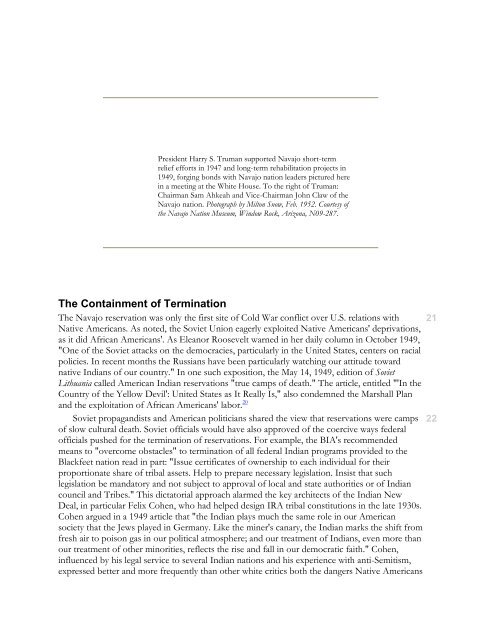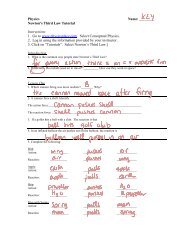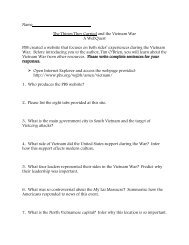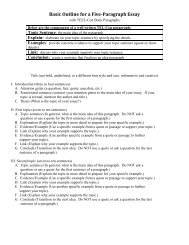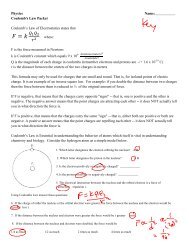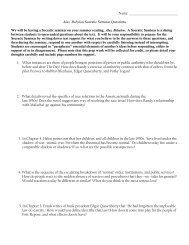our own Navajo <strong>Indian</strong> tribe and none of <strong>the</strong>m who need help any worse, and <strong>the</strong>y owe <strong>the</strong>irobligations to us North American <strong>Indian</strong>s First." 16Those statements gave voice to a central critique made by Native Americans: Ra<strong>the</strong>r than 18fulfill promises made to people who shed blood for America and for <strong>the</strong> preservation offreedom around <strong>the</strong> world, <strong>the</strong> United States was instead bestowing on European nations,including former enemies, vast sums via <strong>the</strong> European Recovery Program, <strong>the</strong> Marshall <strong>Plan</strong>.Non-<strong>Indian</strong>s also used <strong>the</strong> trope and <strong>the</strong> trauma of Native American poverty, especially Navajopoverty, to criticize <strong>the</strong> European focus of <strong>the</strong> Marshall <strong>Plan</strong>. A November 1947 Los AngelesExaminer article, part of a series called "The Citizens America Forgot," stated that "while <strong>the</strong>United States is sending billions for <strong>the</strong> relief of stricken Europe, Navajo <strong>Indian</strong>s face slowstarvation in <strong>the</strong> vast concentration camp of <strong>the</strong> desert." The Examiner article cut both ways,however, painting <strong>the</strong> Navajo as passive victims confined in a "concentration camp" against <strong>the</strong>irwill while capturing a difficult truth about <strong>the</strong>ir material conditions. 17Moving to head off criticism of <strong>the</strong> Marshall <strong>Plan</strong>, still under review by <strong>the</strong> Congress, <strong>the</strong> 19Truman administration asked Congress to provide emergency relief to <strong>the</strong> Navajo and <strong>the</strong> Hopi;Truman hoped that such aid "forecloses those who would criticize my foreign aid program on<strong>the</strong> ground that we are letting our First Americans starve." With Truman's support, Congressappropriated $500,000 in emergency relief in December 1947 and <strong>the</strong>n in 1950 provided longrangefunding of over $88 million in <strong>the</strong> Navajo-Hopi Rehabilitation Act, <strong>the</strong> equivalent of aNavajo-Hopi Marshall <strong>Plan</strong>. The House of Representatives fashioned <strong>the</strong> emergency relief bill in<strong>the</strong> middle of a debate on foreign aid, embedding <strong>the</strong> Navajo and Hopi question in <strong>the</strong> contextof international assistance. It is important to note that Truman and <strong>the</strong> Congress first respondedto <strong>the</strong> Navajo crisis in 1947, less than a month after <strong>the</strong> release of <strong>the</strong> report of <strong>the</strong> President'sCommittee on Civil Rights, which highlighted both <strong>the</strong> "moral" and <strong>the</strong> "international" reasonsfor addressing U.S. treatment of "underprivileged people." During <strong>the</strong> <strong>Cold</strong> <strong>War</strong>, Americanpresidents and federal officials paid attention to how <strong>the</strong>ir resolution of domestic policies wouldplay internationally. Emphasizing <strong>the</strong> impact of foreign criticism of federal <strong>Indian</strong> policy,Secretary of <strong>the</strong> Interior Julius Krug testified in favor of <strong>the</strong> Navajo-Hopi Rehabilitation Act inearly 1949 by asserting that Congress's passage of <strong>the</strong> bill would "consequently streng<strong>the</strong>n thisNation's international prestige and moral position." 18The Navajo (and Hopi) alone benefited from this <strong>Cold</strong> <strong>War</strong> imperative; D'Arcy McNickle, a 20BIA official who championed <strong>Indian</strong> self-determination, later complained: "Possibly <strong>the</strong> o<strong>the</strong>rtribes did not get enough newspaper publicity; perhaps <strong>the</strong>y were not near enough tostarvation—though <strong>the</strong>y might dispute this." In addition to stimulating federal efforts toforeclose criticism of <strong>the</strong> Marshall <strong>Plan</strong> and to improve race relations and thus America's imageabroad, Navajo poverty generated aid from private charity groups, which saw <strong>the</strong> Navajo, byvirtue of <strong>the</strong>ir wartime service, as especially deserving of <strong>the</strong>ir help. And <strong>the</strong> Navajo nation, givenits large population and expansive lands, had <strong>the</strong> literal and figurative shape of a nation. Thesubcommittee of <strong>the</strong> House Committee on <strong>Indian</strong> Affairs that sanctioned <strong>the</strong> federal relief efforthad noted that "this is a nation within our borders, recognized by treaty, that is actually in needof relief." Recent discoveries of uranium ore in <strong>the</strong> Colorado plateau of <strong>the</strong> four-corner area ofArizona, Colorado, New Mexico, and Utah may also have solidified federal commitments torelief, marking <strong>the</strong> Navajo reservation as an important <strong>Cold</strong> <strong>War</strong> site for material as well as moralreasons. The Navajo participated in <strong>the</strong> making of <strong>the</strong> atomic West by facilitating uraniummining, as <strong>the</strong> Navajo Tribal Council put it, "in <strong>the</strong> interest of <strong>the</strong> nation and <strong>the</strong> NavajoReservation." 19
President Harry S. Truman supported Navajo short-termrelief efforts in 1947 and long-term rehabilitation projects in1949, forging bonds with Navajo nation leaders pictured herein a meeting at <strong>the</strong> White House. To <strong>the</strong> right of Truman:Chairman Sam Ahkeah and Vice-Chairman John Claw of <strong>the</strong>Navajo nation. Photograph by Milton Snow, Feb. 1952. Courtesy of<strong>the</strong> Navajo Nation Museum, Window Rock, Arizona, N09-287.The Containment of TerminationThe Navajo reservation was only <strong>the</strong> first site of <strong>Cold</strong> <strong>War</strong> conflict over U.S. relations with 21Native Americans. As noted, <strong>the</strong> Soviet Union eagerly exploited Native Americans' deprivations,as it did African Americans'. As Eleanor Roosevelt warned in her daily column in October 1949,"One of <strong>the</strong> Soviet attacks on <strong>the</strong> democracies, particularly in <strong>the</strong> United States, centers on racialpolicies. In recent months <strong>the</strong> Russians have been particularly watching our attitude towardnative <strong>Indian</strong>s of our country." In one such exposition, <strong>the</strong> May 14, 1949, edition of SovietLithuania called American <strong>Indian</strong> reservations "true camps of death." The article, entitled "'In <strong>the</strong>Country of <strong>the</strong> Yellow Devil': United States as It Really Is," also condemned <strong>the</strong> Marshall <strong>Plan</strong>and <strong>the</strong> exploitation of African Americans' labor. 20Soviet propagandists and American politicians shared <strong>the</strong> view that reservations were camps 22of slow cultural death. Soviet officials would have also approved of <strong>the</strong> coercive ways federalofficials pushed for <strong>the</strong> termination of reservations. For example, <strong>the</strong> BIA's recommendedmeans to "overcome obstacles" to termination of all federal <strong>Indian</strong> programs provided to <strong>the</strong>Blackfeet nation read in part: "Issue certificates of ownership to each individual for <strong>the</strong>irproportionate share of tribal assets. Help to prepare necessary legislation. Insist that suchlegislation be mandatory and not subject to approval of local and state authorities or of <strong>Indian</strong>council and Tribes." This dictatorial approach alarmed <strong>the</strong> key architects of <strong>the</strong> <strong>Indian</strong> NewDeal, in particular Felix Cohen, who had helped design IRA tribal constitutions in <strong>the</strong> late 1930s.Cohen argued in a 1949 article that "<strong>the</strong> <strong>Indian</strong> plays much <strong>the</strong> same role in our Americansociety that <strong>the</strong> Jews played in Germany. Like <strong>the</strong> miner's canary, <strong>the</strong> <strong>Indian</strong> marks <strong>the</strong> shift fromfresh air to poison gas in our political atmosphere; and our treatment of <strong>Indian</strong>s, even more thanour treatment of o<strong>the</strong>r minorities, reflects <strong>the</strong> rise and fall in our democratic faith." Cohen,influenced by his legal service to several <strong>Indian</strong> nations and his experience with anti-Semitism,expressed better and more frequently than o<strong>the</strong>r white critics both <strong>the</strong> dangers Native Americans


